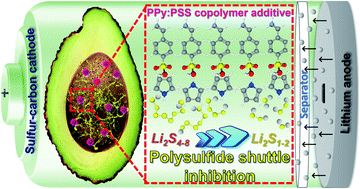Synergistic effect between PPy:PSS copolymers and biomass-derived activated carbons: a simple strategy for designing sustainable high-performance Li–S batteries†
Abstract
An activated carbon from the seed of an avocado, a fruit highly and increasingly demanded by consumers, has been used as a sulfur host for lithium sulfur (Li–S) batteries. Although the performance of the resulting composite is acceptable at low current densities, the discharge capacity is stabilized at about 780 mA h g−1 after 250 cycles at 0.1C. It is poor at higher currents, about 75 mA h g−1 after 500 cycles at 5C. Carbon impregnation with a dual copolymer, polypyrrole (PPy) and polystyrene sulfonate (PSS), with conductive properties of an electronic and ionic type, respectively, not only improves the performance of the electrode at low current densities, about 1200 mA h g−1 after 250 cycles at 0.1C, but also at high currents, 640 mA h g−1 after 500 cycles at 5C. We believe that the copolymer not only improves the electrode conductivity, reflected in the electrochemical behaviour of the cell through different parameters such as a notable decrease in charge transfer resistance and an increase in the Li+ diffusion coefficient, but also increases the capacity of inhibition of the polysulfide migration because of the presence of heteroatoms (N, O, S) in its structure.

- This article is part of the themed collection: Energy Frontiers: Electrochemistry and Electrochemical Engineering


 Please wait while we load your content...
Please wait while we load your content...